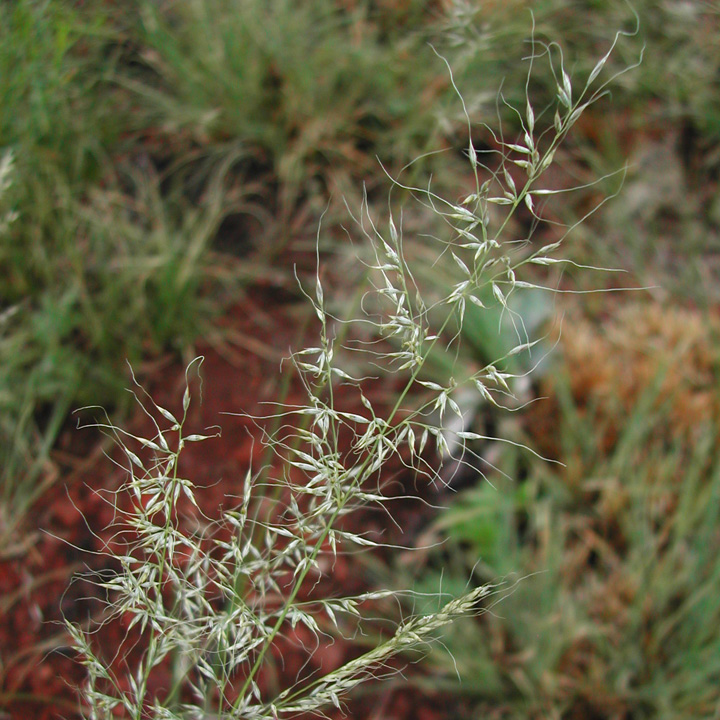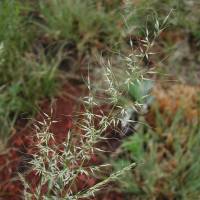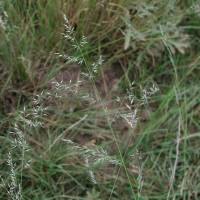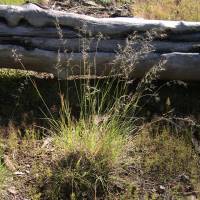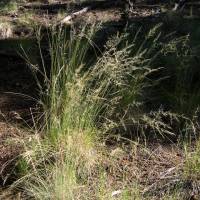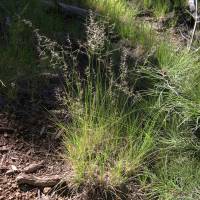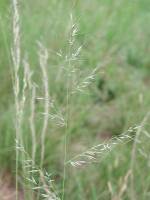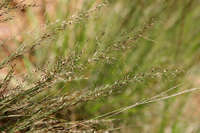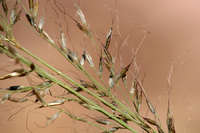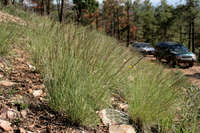Plants perennial; cespitose, not rhizomatous. Culms 10-80 cm, erect, rounded near the base; internodes glabrous. Sheaths smooth or scabridulous, becoming flattened, papery, and occasionally spirally coiled when old, lower sheaths longer than the internodes; ligules 4-14(20) mm, membranous, acute to acuminate; blades 6-25 cm long, 1-2.5 mm wide, flat, becoming involute, scabrous abaxially, hirsute adaxially. Panicles 4-25 cm long, (1)2-6 cm wide, not dense; primary branches 0.5-10 cm, appressed or diverging up to 40° from the rachises; pedicels 0.5-6.5 mm, scabrous. Spikelets 3-7 mm. Glumes subequal, (1)1.5-3.2(4) mm, smooth or scabridulous distally; lower glumes 1-veined, sometimes with a less than 1 mm awn; upper glumes 1/3-2/3 as long as the lemmas, 3-veined, truncate to acute, 3-toothed, teeth sometimes awned, awns to 1.6 mm; lemmas 3-4.5(7) mm, lanceolate, loosely to densely appressed-pubescent on the lower portion of the midveins and margins, hairs to 0.8 mm, apices acute to acuminate, awned, awns (2)6-25 mm, flexuous; paleas 3-4.5(7) mm, lanceolate, acute to acuminate; anthers 1.5-2.3 mm, purplish. Caryopses 1.8-2 mm, fusiform, light brown. 2n = 20, 40.
Muhlenbergia montana grows on rocky slopes and ridge tops and in dry meadows and open grasslands, at elevations of 1400-3500 m. Its range extends from the western United States to Guatemala. Muhlenbergia montana is sometimes difficult to distinguish from M. filiculmis, but that species has shorter spikelets and lemma awns and tightly involute or filiform, sharp blades.
Common Name: mountain muhly
Duration: Perennial
Nativity: Native
Lifeform: Graminoid
General: Densely tufted perennial grass with stems 10-80 cm, rounded (terete) near the base; internodes glabrous.
Vegetative: Blades 6-25 cm long, 1-2.5 mm wide, flat, becoming involute, scabrous below, hirsute above; ligule membranous and delicate, 4-14 mm, acute to acuminate; sheaths smooth or scabridulous, becoming flattened, papery, and occasionally spirally coiled when old;
Inflorescence: Panicles 4-25 cm long, 2-6 cm wide, not dense, yellowish green to purple tinged; primary branches 0.5-10 cm, appressed or diverging up to 40 degrees from the rachises; pedicels shorter than spikelets; spikelets 3-7 mm; glumes subequal, 1.5-3 mm, thin and smooth or minutely roughened toward tip; lower glume with 1-vein, sometimes with an awn less than 1 mm; upper glume one third to half as long as the lemmas, 3-veined, truncate to acute, teeth sometimes awned, awns to 1.6 mm; lemmas 3-4.5 mm, lanceolate, scabrous or variously pubescent on back or the base, blotched with purple, topped with a flexulous awn 6-25 mm.
Ecology: Found on rocky slopes, in forest openings, dry meadows and ridge tops from 4,500-11,500 ft (1676-3505 m); flowers July-November.
Distribution: Western US, from CA to WY, south through UT, CO, AZ, NM, TX, and MEX to Guatemala.
Notes: Muhlenbergia is a large and diverse genus primarily distinguished by having single-flowered spikelets with unequal glumes. M. montana is a distinctive bunch grass in the pine forests. It is difficult to distinguish from M. straminea which overlaps in distribution but that species has leaves that are much more tightly curled as they dry, and it flowers in spring rather than fall. Other tufted muhlys with awned spikelets are M. setifolia and M pauciflora; both of those species have narrower blades usually 1 mm or less wide. In contrast, M. montana usually has wider blades up to 2.5 mm wide, and flattened, ribbon-like lower leaf sheaths. M. montana is considered an important range grass in the southwestern US and northern Mexico.
Ethnobotany: Unknown
Etymology: Muhlenbergia is named for Gotthilf Heinrich Ernst Muhlenberg (1753-1815) a clergyman and botanist from Pennsylvania; montana means of the mountains.
Synonyms: None
Editor: SBuckley 2010, AHazelton 2015


